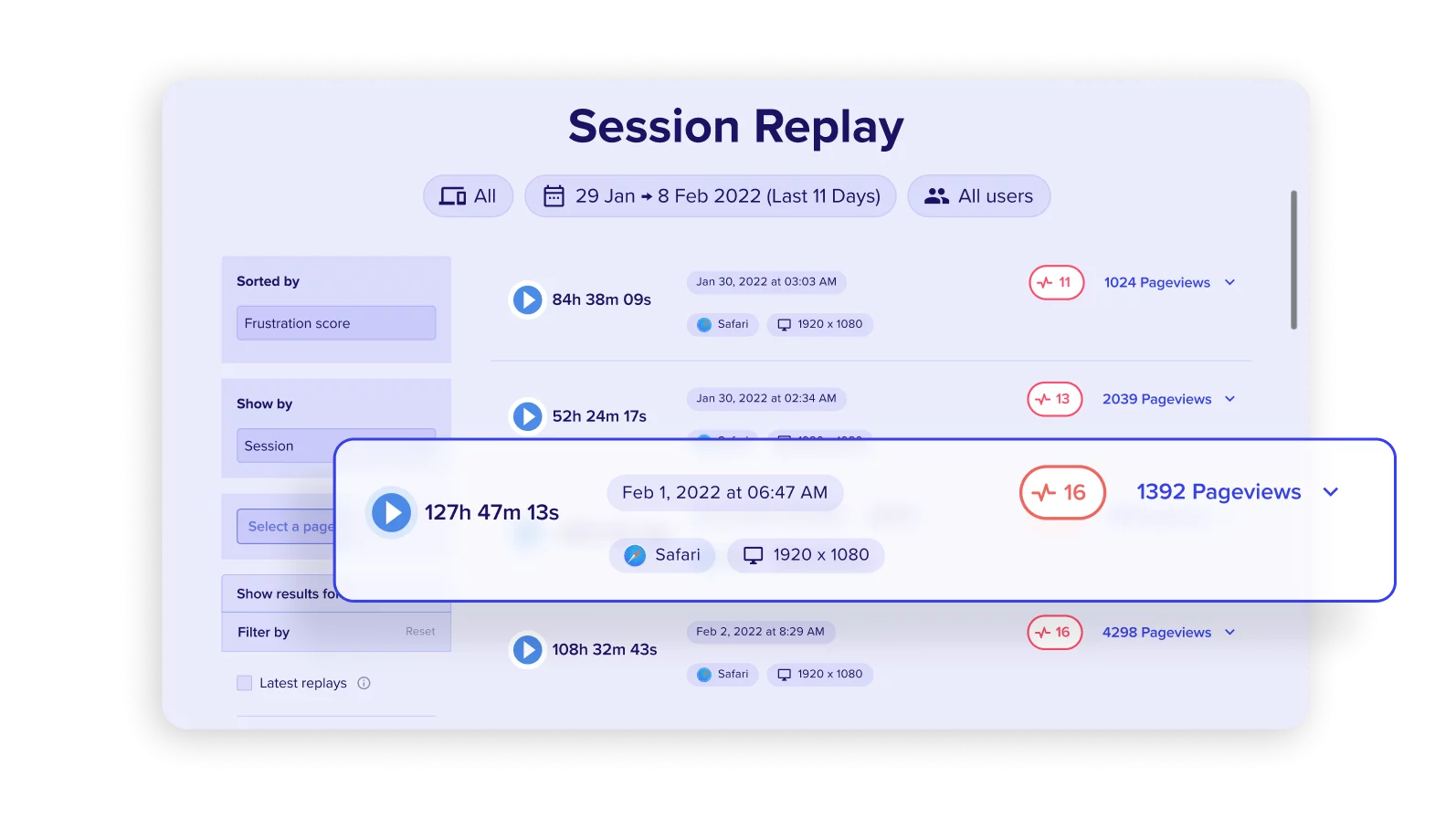
Reconstruct individual visitor sessions to reveal hidden behaviors.

Website sessions are a pivotal part of digital marketing analytics. They encompass the interactions a user has on a website within a specified time frame. Every web page view, social interaction, and transaction is grouped into these sessions.
The standard duration for a session is typically 30 minutes, but this can be adjusted to better reflect the visitor behaviour on the website. The initiation of a session occurs when a user starts browsing a site and ends when the user exits the site or after a period of inactivity, typically 30 minutes. The data derived from these sessions provides valuable insights into user engagement and the overall performance of the website in the digital space.
This information can be utilized to identify trends, evaluate the effectiveness of digital marketing campaigns, and make data-driven decisions about web page design and content. Key metrics derived from the session data include the number of sessions per user, the number of web page views per session, and the average session duration.
Each of these metrics provides a unique perspective on user engagement and website performance. Collectively, they create a comprehensive picture of how users interact with a website, providing valuable insights for enhancing online traffic.
Users, pageviews, and sessions are three fundamental metrics in digital marketing analytics. Users are individuals who have had at least one session within the selected date range. They can be segmented by new or returning users.
Pageviews represent the total number of web pages viewed. Repeated views of a single web page are counted. While users and sessions may seem similar, they represent different aspects of internet browsing engagement.
A single user can have multiple sessions. For example, if a user visits a website in the morning, leaves, and then returns in the afternoon, that would count as two sessions from one user. This distinction is crucial as it allows for a more nuanced understanding of visitor behaviour. Pageviews, on the other hand, represent the total number of individual web pages that were viewed during a session. If a user visits a website and views four different pages, that would count as four pageviews. This metric is useful for understanding which web pages are most engaging or popular among users, thus helping in driving online traffic.

Reconstruct individual visitor sessions to reveal hidden behaviors.
Users, sessions, and pageviews are key metrics in understanding website traffic and user engagement. Users are defined as individuals who visit a website. Each user is typically assigned a unique identifier, allowing for tracking of both new and returning visitors.
This metric provides an overall measure of a website’s audience size. Sessions represent the set of interactions a user takes within a given time frame on a website.
This includes web page views, social interactions, transactions, and more. The standard session duration is 30 minutes, but this can be adjusted based on the specifics of a website. This metric provides insights into user engagement and activity on a website. Pageviews are the total number of web pages viewed by users. This includes repeated views of a single page. Pageviews are a measure of website activity and can be used to identify the most popular or engaging pages. By analyzing these three metrics in conjunction, website owners can gain a comprehensive understanding of their website’s performance and user behaviour, thereby enhancing their digital marketing strategies.
In the realm of digital marketing, understanding the differences between Sessions, Users, and Pageviews is crucial for effective website management and user engagement. Sessions in the context of website analytics represent the total number of visits to your website. Each session encapsulates all the interactions a user may have while browsing your site within a given time frame.
These interactions can range from viewing different web pages, downloading resources, clicking on links, and other browsing activities. Users, on the other hand, are identified as unique individuals who have initiated at least one session on your website.
These can be either new or returning visitors. The differentiation between users is made through a unique, randomly generated client ID assigned when a person visits your website for the first time. This ID, stored in a cookie on the visitor’s device, allows Google Analytics to recognize returning users, thus providing valuable insights into visitor behaviour.
Pageviews are the total number of web pages viewed on your website. This metric counts every single page reload and revisits, meaning repeated views of a single page are counted as well. Pageviews represent the total number of times the content of your website has been accessed, providing a measure of online traffic. It’s common to see a higher number of pageviews than sessions or users, as a single user can view multiple pages in one session.

Reconstruct individual visitor sessions to reveal hidden behaviors.
Website sessions are a key metric in digital marketing and internet analytics.
A frequently asked question is how Google Analytics defines a session. A session is a group of user interactions with your website that take place within a given time frame. A single session can consist of multiple pageviews, event triggers, or transactions, providing a comprehensive picture of user engagement. Another common question is about the duration of a session. By default, a session ends after 30 minutes of inactivity by the user.
However, this duration can be customized in the tracking code settings, allowing for more flexibility in analyzing visitor behaviour. Additionally, a session can end at midnight or if a user arrives via one campaign, leaves, and then comes back via a different campaign.
Many also wonder about the difference between a session and a user. A session represents all the actions a user takes within a certain duration on your website. A user, on the other hand, is an individual who has initiated at least one session on your website. A single user can have multiple sessions, providing valuable insights into the patterns of online traffic.
Scrolling, on its own, does not contribute to a session in Google Analytics.
A session in Google Analytics is defined by user interactions with a website. These interactions can include pageviews, events, social interactions, and transactions. Scrolling on a webpage does not inherently trigger any of these interactions, and therefore does not count towards a session. However, website owners can set up scroll tracking as an event in Google Analytics.
This allows them to measure how far users scroll down on their webpages, providing a deeper understanding of visitor behaviour. Once set up, each time a user scrolls to a certain point on a webpage, it triggers an event that is recorded in Google Analytics.
These scroll events then count towards the total number of interactions in a session. In conclusion, while scrolling does not automatically count as a session, it can be tracked and counted as an interaction if set up as an event. This can provide valuable insights into user engagement and help enhance the effectiveness of digital marketing strategies.

Reconstruct individual visitor sessions to reveal hidden behaviors.